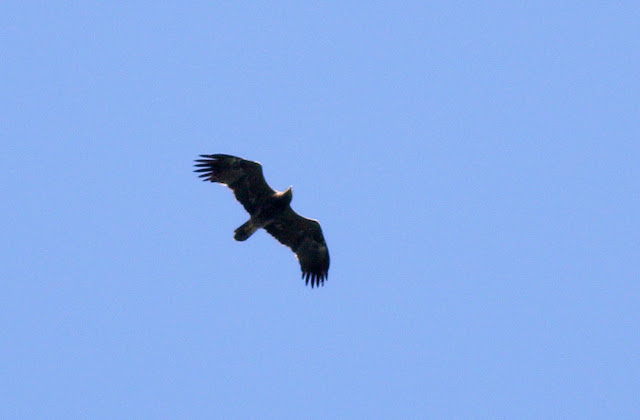 |
| A very close immature. New inner primaries, the odd new secondary and three new tail feathers presumably make it a 2nd cy. |
 |
| In this photo p7 in the right wing looks new compared to the brown p8 and p6? |
 |
| Near adult |
 |
| Adult |
 |
| 2nd cy |
 |
| A dark immature |
 |
| A nice pale juvenile. Primaries lack the pale inner window of juvenile Imperial |
 |
| A typical juvenile |
 |
| Adult type. Typical blackish carpal with no crescent. Long hand. |
 |
| Longish tail and protruding head/neck |
 |
| Regular juvenile |
 |
| Adult. Very difficult to see the barring and dark trailing edge on many birds in the field and often only visible once put into Photoshop and shadow highlights. |
 |
| The dark trailing edge to secondaries is visible here. |
 |
| Long wings especially arm. |
 |
| A different adult to the above bird. Slightly longer and fuller tail than GSE but this seems variable. |
 |
| I had assumed this to be an immature Steppe on shape with it's long wings and broad long fingered hand. |
 |
| I think this immature had survived a tank |
 |
| Juvenile |
 |
| Contrast between new inner and old outer primaries should make it a 2nd cy |
 |
| A different 2nd cy |
 |
| Another 2nd cy, this one lacking the white central underwing band. |
 |
| Adult. |
 |
| 3rd cy. Worn median primaries with newer ones either side. Also several fresh median and outer secondaries. |
 |
| 2nd cy |
 |
| Adult. No barring or trailing edge visible either due to light or it is absent. |
 |
| A different adult to above. This bird has a narrow white crescent to the outer carpal area. |
 |
| 2nd cy |
 |
| Near adult |
 |
| Adult. It appeared to have damage to its left wing, the primaries being less splayed. Also the edge of the primary coverts were hanging down. |
 |
| Very rarely do you see this much detail on an adult Steppe Eagle at Batumi. |
 |
| Same adult as above. |
 |
| Juvenile |
 |
| Juvenile |
 |
| Adult |
 |
| Adult. Very long wings, broad hand and a fairly large tail. |
 |
| A few new inner primaries, worn juvenile outers and a couple of new middle secondaries should make it a 2nd cy. |
 |
| Immature. |
 |
| A large heavy bird with a strong head/neck and bill. |
 |
| The new inner primaries contrasting with the worn outers should make it a 2nd cy. Just surprised how bland the upperwing coverts are. |
 |
| Perhaps 3rd cy. |
 |
| A very distant immature. |
 |
| A very distant juvenile |
 |
| A very dark adult type which accompanied the lower bird. I paid more attention to the very large individual in the lower photos as that one came nearer than this. |
 |
| Solid black carpals with no hint of white at the primary bases. It came pretty close and the only indication of barring was in the inner primaries. |
 |
| A slight grey inner primary window with some light barring visible here. The pale tips to the greater coverts and secondaries I guess point to a younger bird. |







































































